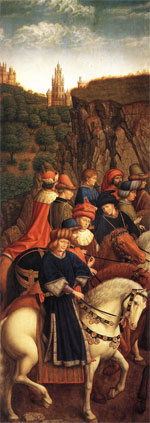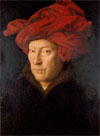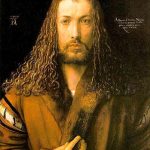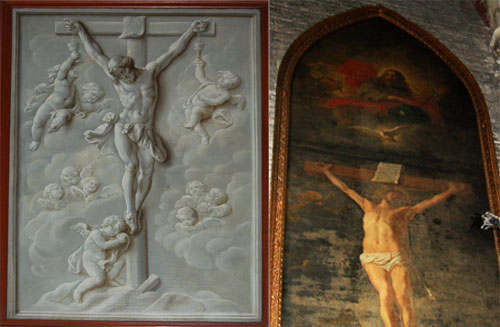Around 1420, a rich Belgian merchant by name of Joost Vijd commisioned an altar piece displaying the Adoration of the Mystic Lamb. The order was given to Flemish master Hubert van Eyck. After his death in 1426, the painting was finished by his famous brother Jan van Eyck.
For a good description of the panel have a look at it’s wikipedia entry or here.
 The relevance of this renowned work of art to the mystery of Rennes-le-Château, was introduced by Dutch author Karl Hammer-Kaatee when he published his book Satan’s Song in 2006. According to Hammer, he had merely written up the life story of a certain Tom R., a retired Dutch secret service agent who had been involved in the allied recuperation of stolen art from the nazis after World War II. Tom allegedly came to Hammer in 1990, after anonimously living in Paris for 30 years, while everybody thought he had died in a sailing accident on the Mediterrenean in 1948.
The relevance of this renowned work of art to the mystery of Rennes-le-Château, was introduced by Dutch author Karl Hammer-Kaatee when he published his book Satan’s Song in 2006. According to Hammer, he had merely written up the life story of a certain Tom R., a retired Dutch secret service agent who had been involved in the allied recuperation of stolen art from the nazis after World War II. Tom allegedly came to Hammer in 1990, after anonimously living in Paris for 30 years, while everybody thought he had died in a sailing accident on the Mediterrenean in 1948.

The story of Satan’s Song, starts at the beginning of World War II. Research by Hammer and others demonstrates that even before the Belgian capitulation of 28th June 1940, a German lieutenant by name of Henry Koehn starts an investigation into the whereabouts of the Ghent Altar piece. He has been given an assignment from an unknown source very high up the nazi chain of command to investigate the whereabouts of the ‘gerechten Richtern’ (Just Judges). By that time, the remaining panels have been transferred to unoccupied Pau in southern France by the Belgian clergy. The Germans eventually find the Altar Piece there in August 1942, cease it and transport it 
The genuine interest of the nazis is demonstrated by the fact that Koehn spent no less than three years trying to find the stolen panel.
the Mystic Lamb

 The official reading is that Joost Vijd commissioned the altar piece to celebrate the erection of his personal foundation. Such foundations were quite common at the time and would secure that enough masses would be said for the founder after his death. Vijd’s foundation was dedicated to John the Baptist. Hammer learnt, that the foundation had only be erected in 1435, three years after the work had been completed by Jan van Eyck and 11 years after he had commissioned it.
The official reading is that Joost Vijd commissioned the altar piece to celebrate the erection of his personal foundation. Such foundations were quite common at the time and would secure that enough masses would be said for the founder after his death. Vijd’s foundation was dedicated to John the Baptist. Hammer learnt, that the foundation had only be erected in 1435, three years after the work had been completed by Jan van Eyck and 11 years after he had commissioned it.
Another anomaly is that it is almost certain that the Van Eyck brothers designed the lay-out and themes of the paintings. Vijd didn’t have the background to do it. That raises a problem because in the 15th century, it was the custom that a detailed contract would be drawn up between the commisioner and the artist, certainly for bigger and expensive works. Artistic license only existed in a very limited form. In case of the Ghent Altar Piece, there was never a contract. Vijd, therefore seems to have been more the man that provided a location and who secured that this incredible piece of craftmanship would be finished by Hubert van Eyck’s brother after his death, even though Jan was travelling all over Europe and possibly further in missions for his employer Philip the Good that were described in the Duke’s administration as “a certain secret journey about which no explanation may be given”. Hubert was buried next to the panel. It would take his brother another 7 years to complete it.

Van Eyck the Map Maker
Jan van Eyck was much more than a painter. His personal motto “Als Ich Can” (As I can) is considered to be a reference to Alchemy. At the time, alchemists were physicists, looking for the working of God in earthly things.

The book ends after a group called the ‘Ebionites’ shows the Arma Christi to Tom R. in 1974.
The “logo” of the Ebionites is a circle with a palm leaf. They also use the Tau cross. Hammer was given a wooden Tau cross with the Ebionites emblem on it, that he wears on several photos.
In the last couple of years, the original Adoration of the Mystic Lamb has been on display in a well guarded chapel inside St. Bavo’s cathedral in Ghent. The painting is not only guarded by the people sitting in the ticket boots. Both at the left and right of the door are quite eery paintings of Christ nailed to a Tau-cross. In at least one of them he is bleeding from his wrists into two chalices. The other one is in such a bad state that it is distinguishable that there is a Tau-cross and his wrists are bleeding but little else.
In the same corner, the 14 beautiful stations of the cross are adorned by murals of angels holding all the Arma Christi, ranging from the ladder to the nails and Crown of Thorns. In the stations themselves too, there is a prominent role for the instruments.
All this is located within 10 metres of the Van Eyck masterpiece. It gives the strong impression that a movement using the Tau-cross is both spiritually and physically guarding the Adoration of the Mystic Lamb to this very day.
©2007-2012 renneslechateau.nl, all rights reserved. Photo of Karl Hammer-Kaatee copyright Karl Hammer-Kaatee





A very interesting story about a very interesting subject. The picture of te Just Judges on your site is a copy of VanderVeken. Some researchers think the panel is stolen because it hides a secret. Personally I’m not convinced it does, but the whole altarpiece is very special!
On my website you can find “for free” my e-book, with my own testimony about the case of the theft of the panel the Just Judges . I am 79 years old, from Belgium- Wetteren, the place where was living Arsène Goedertier,who was till now still called the thief of the panel . I am sure he was not .
He confessed by his dead he was the only-one who knowns where the Just Judges are. After his dead, they found the copys of the letters, he (or someone else ?)has send to the bisshop of the St. Baafscathedral .
I was on the cemetery, when Oberleutnant Henry Koehn , during war II in 1942, was opening the graves from Goedertier, D’Hooghe and Vilain XIIII , and also another tomb.
I agree with CR=10 that you have placed the wrong panel (copy of Vanderveken)
In the real panel Van Eyck had painted the rocks different . You can see allso a face in the rock, that’s sure . An certain other difference was that the hat (bonnet) of the first Judge is going over the face of the following Judge.
It would be interesting if you would post here the original panel of the Judges, because I think there could be a message in this panel :the face in the rock = looking of the face of Christ (De visione Dei)
I am allso convinced that the panel was stolen, not for the money, but that the real reason is the connection with the Holy Grail and his really heir (the war about this, during all enturys and the claiming of the power over the world .
It is stolen for politic-economic and social power .
The whole altarpeace is indeed very beautyfull, full of symbols (f.i. the TAU-cross on different places and indeed very special .
Sorry for my bad English .
Maria-Vilain
Hi! I was surfing and found your blog post… nice! I love your blog. :) Cheers! Sandra. R.